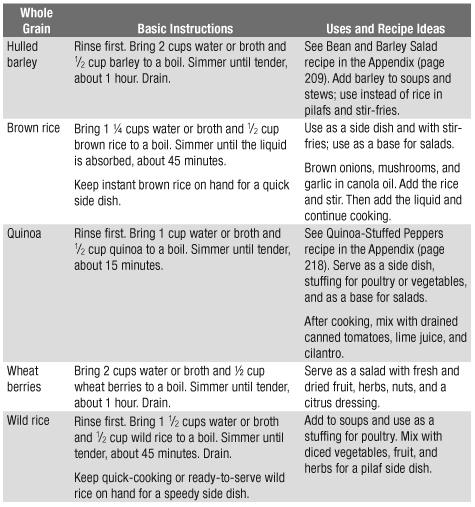
Our food focus this month is whole grains. We’ll look at what they are, how to prepare them, and what to look for on food labels. The lifelong skill that you’ll practice this month is how to recognize and overcome the obstacles that tend to wreck diet and fitness plans.
For the Long Haul: What Will You Gain from Whole Grains?
Americans eat only 15% of the recommended amount of whole grains, yet we eat 200% of the recommended limit of refined grains. Some people find whole grains scary because they don’t know what to do with them. Others swear they’re dry and tasteless. Most likely, they just haven’t eaten whole grains that have been well prepared or seasoned. By trading in a few servings of refined grains for whole grains, you’ll take in more nutrition. Other research suggests eating whole grains is linked to a reduced risk of heart disease, stroke, certain cancers, and type 2 diabetes.
Whole grains include the entire grain seed: germ, bran, and endosperm. Even if the grain has been processed like it is in whole-wheat bread or whole-wheat spaghetti, it will contain all three parts of the grain. Some whole grains, like oats and brown rice, are easy to identify. Others, like whole wheat, are not so easy to identify because package labels tend to be tricky. “Made with whole grains” and “contains whole grains” are not guarantees that a product is mostly whole grain because manufacturers can make these claims even when the amount of whole grain in the product is minuscule. Look at the ingredients list to decide if the product is worth buying. If the first ingredient contains the word “whole,” as in whole-wheat flour or whole-grain rye, then the product is largely whole grain. If you see “enriched wheat flour” listed first, put the product back. That’s the long way to say white flour. Another method to identify whole grains is to look for the Whole Grain Stamp. If a food has a stamp on the package, it contains at least one-half serving of whole grains. Learn more about the Whole Grain Stamp at the Whole Grains Council website (www.wholegrainscouncil.org).
Try Some New Whole Grains

You will always face obstacles to eating well and taking care of yourself. Your keys to success are recognizing these hurdles and even anticipating them before they get in your way. If you’re planning to celebrate a friend’s birthday with a big buffet brunch, for example, you’ll need to plan ahead to know which strategies you’ll use to avoid overeating. Sometimes the obstacles are a little harder to anticipate, but getting in the habit of looking for potential problems will help you successfully navigate your way through them. Use the HURDLE method to overcome obstacles. The worksheet in the Appendix will help you through each step.
HURDLE
H: How is your upcoming schedule different from your usual routine? Look ahead at your week’s calendar and your day’s appointments. Is there something unusual or at an unusual time?
U: Understand how any of these appointments or obligations could derail you from eating well or exercising, or otherwise get in the way of good self-care. Will they suck time out of your day or will someone else be in control of your food choices? Will you be forced to miss your favorite spin class or will you be in the car during your usual lunch hour?
R: Record your options. Brainstorm and write down every possible solution to your problem, no matter how silly it seems.
D: Decide on a solution. Review each option with an open mind. Ask yourself if you can carry it out. Do you have control, or do you need to ask for help? Is it likely to bring about the desired result?
L: List the steps you’ll need to take to put the solution into practice. Know what you will do and when you will do it.
E: Exercise your choice and Evaluate it. Carry out your selected option. Make some notes about how well your plan worked and what you will do differently next time.
Here’s an example:
H: How: Judy’s daughter is in a soccer tournament. If the team continues to win, her daughter will have games every night for the next six days. Judy will know her daughter’s schedule only one day in advance, and to see her daughter play, Judy may have to drive as much as an hour out of town.
U: Understand: Judy can’t be certain if she’ll be home for dinner any day this week.
R: Record: Judy records these options.
• Miss the soccer games
• Drink a meal-replacement shake and eat a piece of fruit in the car instead of eating a regular dinner
• Pick up a fast-food dinner after checking the restaurant’s nutrition information
• Organize a “healthy” potluck with several of the other moms
• Eat dinner very late, about 9:30
• Pack a different dinner each night
Notice that “winging it and hoping for the best” is not one of Judy’s recorded options. Judy has tried that before, and it backfired. Last year she ate whatever food was available at the soccer field or on the way to the games, which meant Judy didn’t eat well that whole week.
D: Decide: Judy opts for two solutions because this obstacle might continue for six days. She chooses to alternate between having a meal replacement and a piece of fruit in the car with packing a dinner she can eat at the game.
L: List: Judy lists these steps in her action plan.
• Choose an appropriate meal replacement
• Write out menus for dinners she can pack
• Shop for meal replacements, fruit, sandwich fixings, and other items for her bagged meal
• Dig her extra-large lunch bag out of the hall closet
• Be certain that her blue ice packs are kept frozen and that she returns them to the freezer each night
• Wake up 10 minutes earlier each morning to pack her meal
E: Exercise and Evaluate: After the soccer tournament, Judy was pleased with her success, although a few nights she finished her meal feeling slightly hungry. She’s already planning for next time: she’ll keep some nuts or raw veggies with her in case the meal she packs isn’t enough to keep her satisfied.
 Continue the following goals: _____________________________________________________________
Continue the following goals: _____________________________________________________________